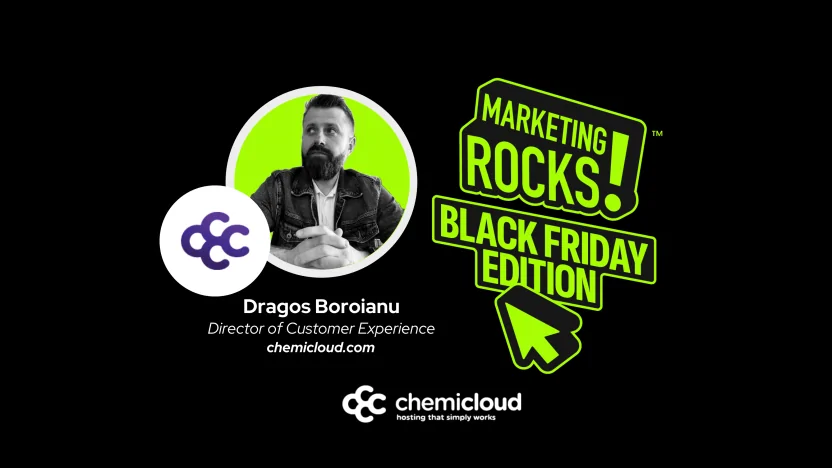🙌 Mulțumesc, Sinaps! / Thank You, Sinaps!
First things first: a sincere thank you to the Sinaps team and to everyone who worked behind the scenes to make the Marketing Rocks – Black Friday Edition such a success. It was a pleasure to join the lineup as a speaker and to contribute a practical, technical perspective to an event packed with marketing strategy, platform insights, and hands‑on advice from leaders across the ecosystem. The energy in the (virtual) room was fantastic, and the Q&A made it clear that Romanian entrepreneurs are laser‑focused on doing Black Friday better this year—and sustaining that performance all year long.
Why Hosting Matters More Than Most People Think
In my talk, I emphasized a simple but often overlooked truth: hosting is not “just infrastructure.” It’s part of your sales engine. When your store is running slow or crashing, campaign budgets are wasted, customers lose patience, and your brand trust suffers. Conversely, when your site is fast, stable, and responsive—even under pressure—every channel performs better: paid traffic converts higher, organic sessions stick around longer, and repeat buyers feel confident every time they return.
Black Friday is the ultimate stress test. It exposes bottlenecks in your entire digital stack: theme and plugins, custom code, caching, CDN, database, and yes—your hosting platform. If the foundation is weak, everything on top shakes. If the foundation is solid, your marketing finally gets the chance to perform at its true potential.
Three Questions to Ask Before Black Friday
- Is my current hosting truly ready for Black Friday traffic?
- Do I see warning signs that I should switch providers?
- If I decide to migrate, do I know what to look for in a better platform?
These questions help you get honest about your baseline. If you’ve had even minor downtime, unexplained 5xx errors, slow admin, or checkout lag under traffic, those “small” issues often turn into big problems on the biggest shopping day of the year. Fixing them before your campaign goes live is one of the highest‑ROI actions you can take.
How Slow Hosting Eats Your Revenue
Speed is not a vanity metric; it’s a conversion driver. Numerous industry analyses show that each additional second of load time can significantly depress conversions. That’s amplified during peak shopping events where buyer intent is high but customer patience is low. Practically, here’s what we see in real stores:
- Cart abandonment spikes when product pages, cart, or checkout stutter.
- Support tickets increase as users report timeouts or payment failures.
- Paid traffic underperforms because landing pages don’t render quickly enough.
- Brand trust erodes: a frustrated visitor is far less likely to return—even if you fix the issue later.
Black Friday isn’t just a marketing campaign. It’s a live, high‑stakes performance test for your entire eCommerce stack.
Self‑Audit: Is Your Hosting the Bottleneck?
| Check | Why It Matters |
|---|---|
| Does your site load in < 3 seconds for customers? | Speed drives conversion, especially on mobile and during high‑intent bursts. |
| Any recent downtime (even 5–10 minutes)? | Every minute costs money and erodes customer trust. |
| Support response times from host < 10 minutes? | When a checkout breaks at 21:00, you can’t wait until morning. |
| Is the admin dashboard sluggish? | Slow back‑office = slower ops = fewer fixes during peak. |
| Are backups & restores fast and tested? | You need rollback options when changes go sideways. |
Preparation Timeline for Black Friday
- 2–4 weeks before: If in doubt, migrate early. Don’t leave platform choices to the last 72 hours.
- 10–14 days before: Run a mini‑campaign (discount + newsletter + social push) to simulate real traffic or why not use loader.io to simulate trafic and see how your website performs.
- 7–10 days before: Confirm CDN is active, caching rules are sane, image formats are optimized (WebP/AVIF), and critical CSS is handled.
- 3–5 days before: Freeze non‑critical changes. Keep deploys to security fixes, content tweaks, and prices.
- 24–48 hours before: Double‑check backups, 2FA for critical accounts, payment gateway status pages, and escalation contacts.
If you want to load‑test or validate your current stack under realistic pressure, let me know—there are safe ways to simulate behavior without breaking anything in production and without violating provider terms.
What “Good Hosting” Looks Like (Especially for WordPress)
| Capability | What to Look For | Impact |
|---|---|---|
| Compute | Modern CPUs (e.g., AMD EPYC series), generous PHP workers, optimized PHP OPcache | Handles concurrency during spikes without timeouts |
| Storage | NVMe Gen4/Gen5 SSDs | Fast product/catalog queries, quicker writes at checkout |
| Network | Integrated or supported CDN with HTTP/2 or HTTP/3 | Global latency reduction and smoother media delivery |
| Caching | Server‑level caching (e.g., LiteSpeed), proper cache rules for Woo/EDD | Orders keep flowing while pages stay fast |
| Scalability | Easy plan upgrades, vertical resources on demand | Absorbs traffic bursts without complex re‑architecture |
| Security | WAF, rate‑limiting, bot management, automatic patching | Fewer interruptions from attacks during campaigns |
| Observability | Access to logs, metrics, slow query insights | Faster incident resolution and better long‑term tuning |
| Support | 24/7/365, response in minutes, actual WordPress expertise | Rapid recovery when issues hit outside 9–5 |
Field Notes: Before vs After a Smart Migration
Here’s a pattern we’ve seen repeatedly with stores that moved in time for major events:
Before
- Page loads > 3–10 seconds, sometimes worse under ads
- Admin actions (add/edit product) take 30–60 seconds
- Checkout bottlenecks when 100+ users pile in
- Random 5xx under concurrency; fragile cache config
- Slow or “email‑only” support in critical windows
After
- Sub‑second page loads for critical flows
- Responsive admin: bulk edits, imports, and promos move faster
- Stable checkout under hundreds of concurrent visitors
- Predictable caching; no mystery invalidations mid‑campaign
- Hands‑on support with clear SLAs and escalation paths
That shift—from fragile to reliable—translates directly into revenue. With the same creatives, the same budget, and the same products, a faster, more stable store wins more often.
Romania’s eCommerce Growth & What It Means
Romania’s eCommerce market has continued to expand, and with it, customer expectations. Page speed and stability aren’t “nice‑to‑have” anymore; they’re table stakes. Many SMB stores still lose share during Black Friday not because their offers aren’t competitive, but because their infrastructure can’t carry the campaign. The winners deliver a smooth experience from ad click to order confirmation, no matter the hour.
A Practical Checklist for the Week of the Event
- Payment gateways: Monitor status pages; enable fallback gateway if available.
- CDN & cache: Pre‑warm key pages (home, category, best sellers, checkout).
- Images: Ensure hero videos are lazy‑loaded or replaced with lightweight posters.
- Search & filters: Test with live data volumes; avoid unindexed queries.
- Checkout: Test guest + logged‑in; test coupon paths; test failed payments.
- Backups: Have both file and database backups; verify restores.
- Ops runbook: Define who does what if KPIs dip (TTFB, error rates, checkout success).
Support That Shows Up When It Matters
One theme that resonated with the audience: support in minutes, not hours. Black Friday problems rarely occur Tuesday at 11:00. They strike Friday at 22:30, or Sunday night when a promo goes viral. Make sure your hosting partner has real 24/7 coverage with people who understand WordPress, caching, queues, and database behavior—so you can get back to green fast.
“Black Friday Trece. Clienții Rămân.”
That was one of my closing lines in the webinar, and it captures the long‑term view you need. Peak events are critical, but the daily experience is what compounds growth. Fast, reliable hosting doesn’t just protect you during Black Friday—it improves every visit the rest of the year. Customers come back, leave stronger reviews, and recommend you forward.
What to Do If You’re Not Confident in Your Stack
- Get a second opinion: A quick review of your stack (hosting plan, PHP workers, cache, CDN, database) can reveal easy wins.
- Migrate with time to spare: Done early, migration is boring—in the best way. Done late, it’s risky.
- Focus on the money pages: Category, product, cart, and checkout. Make them unbreakable.
- Instrument your store: Track TTFB, error rates, queue times, and payment success. What you measure, you improve.
Watch the Full Session (Romanian)
Missed the live webinar? You can watch the complete recording below. The presentation and Q&A are in Romanian, tailored to the local market and common platform setups.
Final Thanks & Next Steps
Huge thanks once again to Sinaps for the invitation and for orchestrating a high‑value event for the Romanian eCommerce community. If you’d like help evaluating whether your hosting is holding back conversions—or you want a migration plan that won’t derail your campaigns—feel free to reach out. I’m happy to share a checklist, run a quick audit, or point you toward the most impactful next step for your store.
TL;DR: Hosting is part of your sales engine. Prepare early, test realistically, and choose a platform that’s fast, stable, scalable, and supported by experts who show up when it counts. Black Friday may be the test, but the compounding gains happen every day after.



